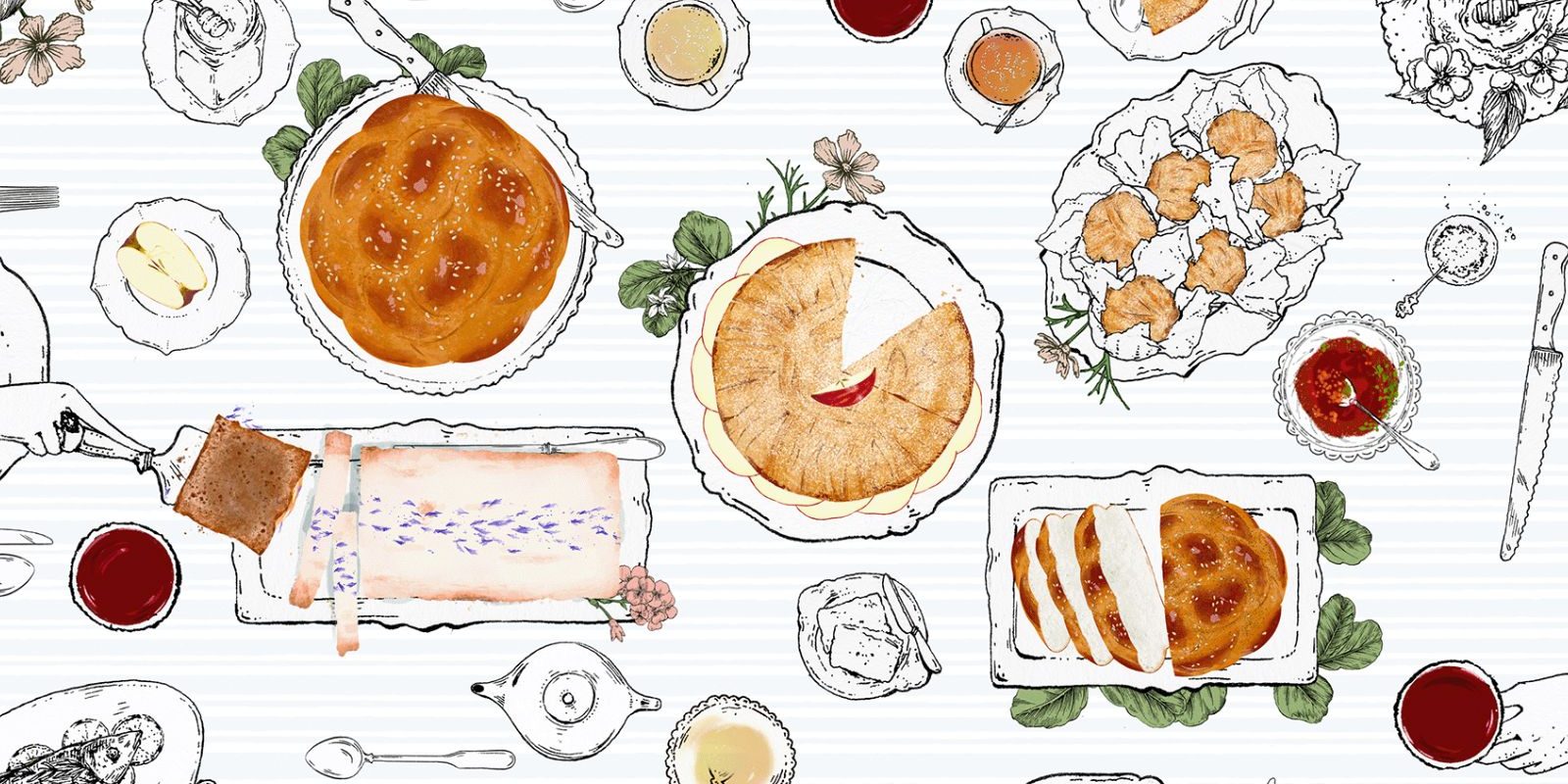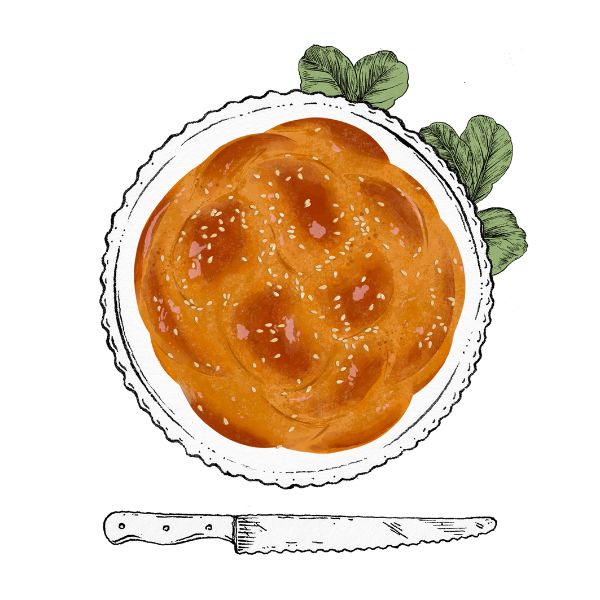Words: Charlie Monaghan
Illustrations: Gail Gosschalk
A holiday guided by the farming calendar, with the sharing of bread and seasonal food at its heart? Rosh Hashana is our sort of holiday. Here, Ronit Vered, Israeli food researcher and journalist for the newspaper Haaretz, talks us through what’s on the festive table, and what it all means…
For years we have been baking special breads and cakes at the beginning of autumn for the Jewish festival of Rosh Hashanah – you may have even picked up one of our honey or apple cakes, or special round challah loaves during this time. What we have not done, though, is tell you why we do this, or what it means. But as Israeli food journalist and researcher Ronit Vered wisely put it to us recently, “Stories are so important. It is so different to eat something when you know the story behind it.”
So, this year, in the spirit of Rosh Hashanah, we are reflecting on our past oversights and, with the help of Vered, putting our wrongs to right with a guide to Jewish New Year and the foods associated with it. As you’ll discover, the sentiment behind this festival carries a very human message that asks us to consider the inevitable cycle of life… apple cakes will never taste the same again.
Ronit, what is Rosh Hashanah?
Ronit: “The first thing I should say is that I’m not an expert on Judaism, and I am a secular Jew! But I love the history embedded in culinary traditions like Rosh Hashanah, and I enjoy eating food that my ancestors would have eaten a version of – it connects me to my past and the land I share with my ancestors.
“Rosh Hashanah is the beginning of the Jewish year. All Jewish holidays are rooted in the agricultural cycle and the cycle of human life, so it’s not a coincidence that New Year is celebrated at the end of the harvest when there is a sense of change and renewal, of abundance but also death to make way for newness. In agriculture, the time after harvest is a period for reflection and wishing well for the season ahead, and that’s true also for Rosh Hashanah – New Year is not just the beginning of one year, it’s also the end of another.”
What role does food play in Rosh Hashanah?
“All Jewish holidays have food at their heart, but eating plays a particularly important role in Passover and Rosh Hashanah. The Bible instructs you to consume sweet and fatty things at the beginning of the year, which is very telling. For centuries, most people hardly ever ate those things (unlike today) so this was a special time.
“All the foods associated with Rosh Hashanah carry different symbols for what you hope will happen. Some foods symbolise prosperity or increased fulfilment, others the removal of your enemies!
“But cuisine is never static, which is what I love about it. The Jewish diaspora has used the dinner table as a way of reconnecting with their history for centuries, and over time things have been adapted and altered. Embedded in the food of Rosh Hashanah is the history of the Jewish people, the wider Mediterranean region and of cultural and political forces over centuries, which is what’s so interesting about it.”
Let’s get stuck into some examples, then…
Round Challah
“I once asked an academic friend of mine what people ate in ancient times and she said, ‘Bread, bread and more bread.’ The tradition of baking challah at home is something that began with the diaspora, though. In ancient times, a loaf of bread would be part of religious rituals in the temple in Jerusalem, so, once it was gone, making challah was about recreating the temple in one’s new home, as a way to connect with your identity and culture.
“A couple of years ago I curated an exhibition to recreate Jewish food made in the 17th century, so, of course, we asked ourselves what the challah looked like. Challah was bread made for special occasions so it had to be different from ordinary bread. To make it special, challah was sweetened with sugar and enriched with fat for Rosh Hashanah, and if you had eggs you would put them in, but most people were too poor. The idea was for it to taste and smell differently from everyday bread.
“Today challah is eaten all the time but for Rosh Hashanah, the tradition of eating something extraordinary is kept alive with the special round loaf. Like autumn itself, it represents the end and the beginning, a circle that keeps continuing around, like time and the passing of the seasons.
“Remember that a lot of historians refer to the baking of bread as the beginning of human societies. Baking in pre-modern times was very difficult. It took an entire village, literally, so community is fundamental to the history of bread and to the history of food – I like to reflect on this during Rosh Hashanah.”
Read more: Check out our Challah french toast recipe.
Apple Cake
“If you ask an Israeli child what foods are eaten at Rosh Hashanah, they will say apples and honey; they are the most important. Apples are a very interesting thing in Jewish culture. For one, Israel is said to be the land of milk and honey, a phrase that interestingly excludes fruits and vegetables; indeed, Jews who left Egypt are said to have missed them when they left.“
Apples have become so dominant in Jewish culture because of the Ashkenazis. They began making apple cake in Germany and in France, and later in central and eastern Europe. Different regions and groups have different varieties, but in the end they all symbolise sweet prosperity for the year ahead.
Read more: Check out our Apple cake recipe.
Honey Cake
“Honey has lots of meaning in Judaism (again, ‘the land of milk and honey’). In ancient times, honey was sourced only from wild hives, so it was very special and people tended to eat fruit molasses more than they did actual honey. But, some time in the Middle Ages, honey became associated with Rosh Hashanah.
“The symbolism here is quite similar to apples: the hope for a good and sweet year. The two are so closely connected and symbolic, in fact, that an apple dipped into honey is the defining food of Rosh Hashanah.”
Read more: Check out our Honey cake recipe.
New season produce
“Rosh Hashanah has so much to do with the seasons, so fruits and vegetables available at the start of autumn have become closely associated with the holiday table. In modern Israeli cuisine and food culture there is so much emphasis on seasonality, with so many chefs that want to be led by what’s available throughout the year. That way of thinking has even permeated into everyday delis, where, instead of only offering apple and honey cake for Rosh Hashanah like they used to, they are now drawing from the wider tradition to offer a more interesting variety of foods with historical connections to New Year.
“The most important produce for Rosh Hashanah are carrots, pomegranates and pumpkins. The first two symbolise prosperity, while pumpkins represent protection from harm. Today, people prepare glazed carrots in a more Mediterranean way with orange juice, sugar and raisins but, originally, Ashkenazi Jews prepared them by cooking them for hours in lots of goose fat, and the resulting carrots were said to resemble gold coins – again, a symbol of prosperity.”
Fish
“Like with honey, the tradition of eating fish for Rosh Hashanah got going from the 3rd to 5th century CE onward with the Ashkenazis in central and eastern Europe. The original version is made with river fish – carp is common but people used whatever was found in their rivers – which would be ground up into a paste and then stuffed into another fish. It required a lot of work, and you really had to go out of your way to make it.
“I’ve only had the original version once when a Polish chef made it for me, and it was beautiful. Today, gefilte fish, as it is known, are commercially available patties of groundfish that originate from the Jewish diaspora in the US, but they have made their way back to Europe to Israel. It’s another example of how cuisine is constantly being reshaped and exchanged.
“Now, many people prepare fish in a Mediterranean way for Rosh Hashanah, whole roasted with olive oil and tomatoes. It’s a lot more palatable than the whole live carp I remember my grandmother buying and putting in the bath ahead of Rosh Hashanah!”
So there you have it, our table is laid for Rosh Hashanah – we hope this guide will make those apple and honey cakes even more enjoyable. As to why we bake them at all, well, put simply, because we’re interested in any culinary culture with delicious food and stories to tell. Our Italian focaccia, French baguettes and Scandinavian rye loaf are all products of how we look to baking cultures from around the world for inspiration and instruction when putting together our seasonally changing menus. Hungry for more tales? Sign up to our newsletter below to never miss a story.





